-
Membership
Membership
Anyone with an interest in the history of the built environment is welcome to join the Society of Architectural Historians -
Conferences
Conferences
SAH Annual International Conferences bring members together for scholarly exchange and networking -
Publications
Publications
Through print and digital publications, SAH documents the history of the built environment and disseminates scholarship -
Programs
Programs
SAH promotes meaningful engagement with the history of the built environment through its programs -
Jobs & Opportunities
Jobs & Opportunities
SAH provides resources, fellowships, and grants to help further your career and professional life -
Support
Support
We invite you to support the educational mission of SAH by making a gift, becoming a member, or volunteering -
About
About
SAH promotes the study, interpretation, and conservation of the built environment worldwide for the benefit of all
Naples and Campania, Day Five, 17 May 2008
by: Mia Reinoso Genoni
miagenoni@post.harvard.edu
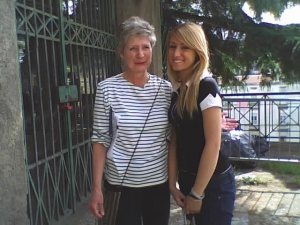
The first of our visits to Early Christian Naples was to the San Gennaro catacombs, where we were not allowed to take pictures, and our intrepid leader Caroline Bruzelius (left) translated in real time as our mandated local guide (right) spoke to us. These catacombs are very important to Naples, and, unlike the Roman catacombs, were never abandoned, staying in use throughout the Middle Ages (and serving as shelter in World War II). San Gennaro is the patron saint of Naples, though he was born in Benevento and martyred via decapitation in Pozzuoli. Our guide related a sweet explanation for this state of affairs, in which she characterized Naples as more open-minded than its neighbors: this open-mindedness and inclusiveness led to a dearth of martyrs so Naples had to borrow one from its more bloodthirsty brethren.
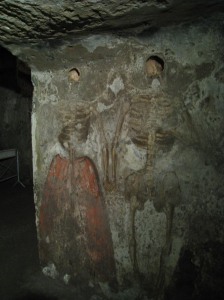
Continuing our tour of Neapolitan catacombs, we visited those of San Gaudioso. Dating to the 5th and 6th centuries, they are located under the church of Santa Maria della Sanita. Here we see an eye-catching part of the catacombs: male and female skeletons painted onto the wall, with a space left for the actual skull.
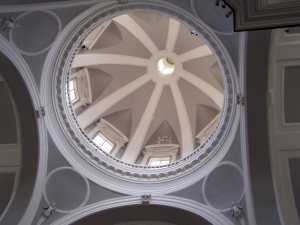
Santa Maria della Sanita was erected from 1602 to 1613 by Fra‘ Guiseppe Nuvolo over the catacombs, which had been rediscovered a few years earlier. This image shows the main dome, but there are 12 small domes created in line with the design of the nave and 2 side aisles.
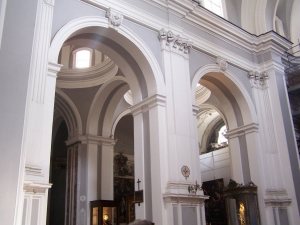
This view of the right aisle shows this division, and the relationship of a dome to the space below.
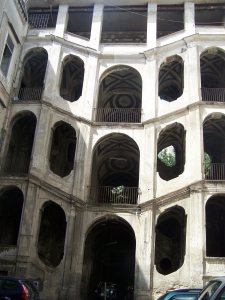
Also in the Sanita quarter is the 18th-century Palazzo Sanfelice, designed by Ferdinando Sanfelice to be his own residence. The complexity and energy of these stairs is typical of Sanfelice’s work.
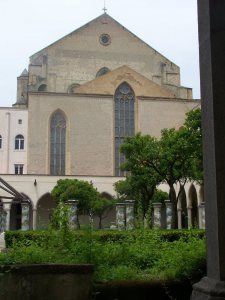
Moving to Angevin Naples, we turned our attention to the late medieval church of Santa Chiara, a fascinating building in the history of Naples and of monastic architecture. It was built by Queen Sancia of Mallorca, an Aragonese noble who had wished to enter the convent but was forced to marry Robert of Anjou for political reasons. Erected from c. 1310-1340, it served a double audience of Franciscan friars and Poor Clares. This view is of the back of the church, taken from the Clarissan cloister, renovated in the 18th-century .
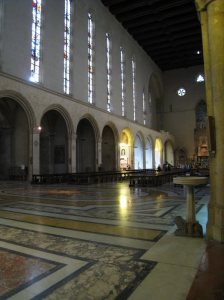
The pious Sancia conceived of it as a true Franciscan institution, as opposed a conventualized one. She envisioned it as a return to simplicity and poverty, yet it served as the de facto church of the royalty. This view toward the altar shows its seemingly paradoxical identity: the church is essentially a Franciscan barn, but a sumptuous one, with Angevin funerary monuments, including that of Robert. This photo reveals something of the plainness, although the building is currently the result of a post-World War II “renovation” that stripped away Baroque decoration to create a Modernist-influenced vision of the original Angevin building.
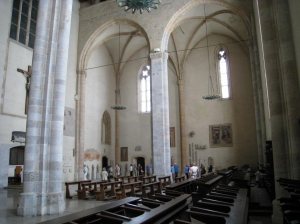
Most fascinating is the solution to the issue of the double populations, both of whom had to face the altar, but one of whom, the Clarissans, could not themselves be seen. Here the nuns’ choir is placed on the other side of the altar, separated from the main church by a wall with a grate, and each join of the grate was topped with an 8-inch spike to ward off inappropriately interested parties.
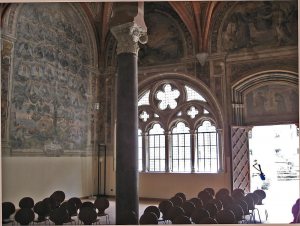
In contrast, San Lorenzo Maggiore is a conventualized Franciscan institution, including a theological school that would have made use of the Chapter House pictured here.
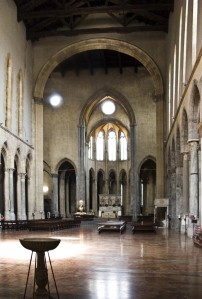
San Lorenzo Maggiore was originally a 6th-century church begun by John the Mediocre. In 1234 it was given to the Franciscans, and subsequently went through a series of medieval renovations and expansions in order to meet the needs of a populace desperate to have prime religious real estate: a tomb or other funerary marker within the building. As it stands today, the church has side chapels and a polygonal apse with a deambulatory and radial chapels to accommodate the demand for memorial spaces.
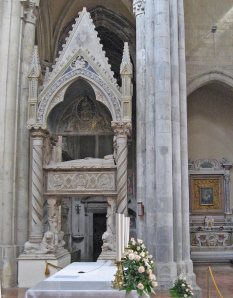
Pictured here is the tomb of Catherine of Austria by Tino di Camaino, dated to c. 1323, located in the deambulatory.
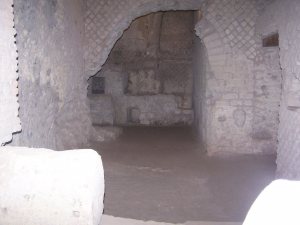
San Lorenzo is also built upon Early Christian ruins. Beneath the church a road and a market have been excavated, featuring stores such as the bakery seen here.
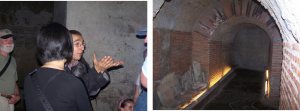
Finally, for those not exhausted, nor faint of heart, nor claustrophobic, there was the option of taking the “Napoli Sotteranea” tour: a trip through ancient ruins primarily located under San Paolo Maggiore. Our guide, who was clearly channeling Roberto Benigni, showed us the Roman theater accidentally discovered in a local family’s basement and the Roman aqueducts that also served as shelter during World War II.
miagenoni@post.harvard.edu

The first of our visits to Early Christian Naples was to the San Gennaro catacombs, where we were not allowed to take pictures, and our intrepid leader Caroline Bruzelius (left) translated in real time as our mandated local guide (right) spoke to us. These catacombs are very important to Naples, and, unlike the Roman catacombs, were never abandoned, staying in use throughout the Middle Ages (and serving as shelter in World War II). San Gennaro is the patron saint of Naples, though he was born in Benevento and martyred via decapitation in Pozzuoli. Our guide related a sweet explanation for this state of affairs, in which she characterized Naples as more open-minded than its neighbors: this open-mindedness and inclusiveness led to a dearth of martyrs so Naples had to borrow one from its more bloodthirsty brethren.

Continuing our tour of Neapolitan catacombs, we visited those of San Gaudioso. Dating to the 5th and 6th centuries, they are located under the church of Santa Maria della Sanita. Here we see an eye-catching part of the catacombs: male and female skeletons painted onto the wall, with a space left for the actual skull.

Santa Maria della Sanita was erected from 1602 to 1613 by Fra‘ Guiseppe Nuvolo over the catacombs, which had been rediscovered a few years earlier. This image shows the main dome, but there are 12 small domes created in line with the design of the nave and 2 side aisles.

This view of the right aisle shows this division, and the relationship of a dome to the space below.

Also in the Sanita quarter is the 18th-century Palazzo Sanfelice, designed by Ferdinando Sanfelice to be his own residence. The complexity and energy of these stairs is typical of Sanfelice’s work.

Moving to Angevin Naples, we turned our attention to the late medieval church of Santa Chiara, a fascinating building in the history of Naples and of monastic architecture. It was built by Queen Sancia of Mallorca, an Aragonese noble who had wished to enter the convent but was forced to marry Robert of Anjou for political reasons. Erected from c. 1310-1340, it served a double audience of Franciscan friars and Poor Clares. This view is of the back of the church, taken from the Clarissan cloister, renovated in the 18th-century .

The pious Sancia conceived of it as a true Franciscan institution, as opposed a conventualized one. She envisioned it as a return to simplicity and poverty, yet it served as the de facto church of the royalty. This view toward the altar shows its seemingly paradoxical identity: the church is essentially a Franciscan barn, but a sumptuous one, with Angevin funerary monuments, including that of Robert. This photo reveals something of the plainness, although the building is currently the result of a post-World War II “renovation” that stripped away Baroque decoration to create a Modernist-influenced vision of the original Angevin building.

Most fascinating is the solution to the issue of the double populations, both of whom had to face the altar, but one of whom, the Clarissans, could not themselves be seen. Here the nuns’ choir is placed on the other side of the altar, separated from the main church by a wall with a grate, and each join of the grate was topped with an 8-inch spike to ward off inappropriately interested parties.

In contrast, San Lorenzo Maggiore is a conventualized Franciscan institution, including a theological school that would have made use of the Chapter House pictured here.

San Lorenzo Maggiore was originally a 6th-century church begun by John the Mediocre. In 1234 it was given to the Franciscans, and subsequently went through a series of medieval renovations and expansions in order to meet the needs of a populace desperate to have prime religious real estate: a tomb or other funerary marker within the building. As it stands today, the church has side chapels and a polygonal apse with a deambulatory and radial chapels to accommodate the demand for memorial spaces.

Pictured here is the tomb of Catherine of Austria by Tino di Camaino, dated to c. 1323, located in the deambulatory.

San Lorenzo is also built upon Early Christian ruins. Beneath the church a road and a market have been excavated, featuring stores such as the bakery seen here.

Finally, for those not exhausted, nor faint of heart, nor claustrophobic, there was the option of taking the “Napoli Sotteranea” tour: a trip through ancient ruins primarily located under San Paolo Maggiore. Our guide, who was clearly channeling Roberto Benigni, showed us the Roman theater accidentally discovered in a local family’s basement and the Roman aqueducts that also served as shelter during World War II.



Leave a commentOrder by
Newest on top Oldest on top